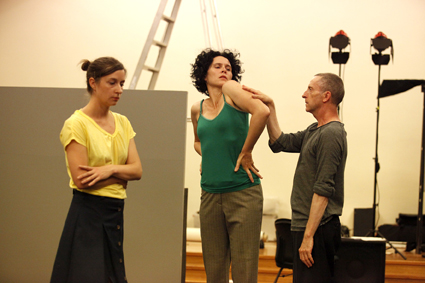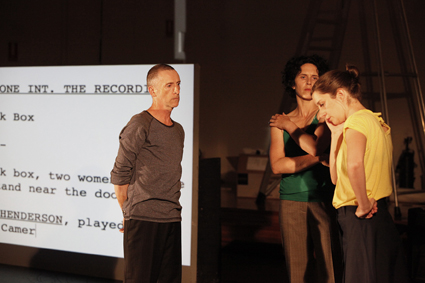dance massive 2013
March 27 2013
dance: installed, immersed, hybridised
keith gallasch: dance massive 2013
quotidian moves, gangnam-style
philipa rothfield: ben speth, wetubelive
dance massive 2013
sounds to dance to, with, against
gail priest: sound design in dance massive 2013
March 26 2013
the life in the work
philipa rothfield: tracie mitchell, dance screen retrospective
youtubing live
varia karipoff: ben speth, wetubelive
dance massive 2013
March 24 2013
dance & disorientation
keith gallasch: tim darbyshire, more or less concrete
more or less monstrous
jana perkovic: atlanta eke, monster body
realtime tv: tim darbyshire, more of less concrete, dance massive 2013
March 22 2013
ritual entwining
philipa rothfield: soo yeun you, [gu:t] [work-in-progress]
strange affliction: dance massive & transcendence
keith gallasch: jo lloyd, future perfect
March 21 2013
a not so private hearing
carl nilsson-polias: tim darbyshire, more or less concrete
realtime tv: antony hamilton, black projects 1& 2, dance massive 2013
something ends, something begins
virginia baxter: dance exchange, dance for the time being - southern exposure
dance massive 2013
the perfection of submission
varia karipoff: jo lloyd, future perfect
March 20 2013
inner fury, seductive skill
philipa rothfield: anouk van dijk, chunky move, 247 days
March 20 2013
old tropes & the new disconnect
carl nilsson-polias: lucy guerin inc & belvoir, conversation piece
March 19 2013
now, then, now
keith gallasch: sandra parker, the recording
realtime tv: anouk van dijk, 247 days, chunky move, dance massive 2013
dance massive 2013
March 18 2013
creating an affective community
jana perkovic: matthew day, intermission
fun and the damage done
keith gallasch: larissa mcgowan, skeleton
more than smoke and mirrors
virginia baxter: ashley dyer, life support
realtime tv: lee serle, p.o.v., dance massive 2013
March 17 2013
realtime tv: dalisa pigram, gudirr gudirr, dance massive 2013
the body un-mirrored
jana perkovic: anouk van dijk, chunky move, 247 days
the origins of feeling
philipa rothfield: sandra parker, the recording
March 16 2013
realtime tv: stephanie lake, dual, dance massive 2013
dance massive 2013
March 15 2013
a dance for dark times
virginia baxter: dalisa pigram, gudirr gudirr
brittle bones & internal electricity
carl nilsson-polias: larissa mcgowan, skeleton
in the thick of it
philipa rothfield: lee serle, p.o.v.
March 15 2013
inside the audience
jana perkovic: lee serle, p.o.v
the poetry of pain
keith gallasch: stephanie lake, dual
dance massive 2013
when two become one
varia karipoff: stephanie lake, dual
March 14 2013
blacker than black
keith gallasch: antony hamilton, black projects 1 & 2
life in a puff
carl nilsson-polias: ashley dyer, life support
March 13 2013
dark symmetries
carl nilsson-polias: antony hamilton, black projects 1 & 2
lines of flight
philipa rothfield: dalisa pigram, gudirr gudirr
dance massive 2013
suggestive formalism
jana perkovic: natalie abbott, physical fractals
unsettling the audience
varia karipoff: natalie abbott, physical fractals
February 22 2013
an intense manifestation of dance
philipa rothfield: dance massive 2013, melbourne
dance massive 2013: from the archive
lucy guerin inc, conversation piece; antony hamilton, black project; atlanta eke, this monster body; matthew day, intermission; jo lloyd, future perfect; tim darbyshire, more or less concrete; natalie abbot, physical fractals; ben speth, wetubelive
 |
Phoebe Robinson, Fiona Cameron, Trevor Patrick, The Recording, Sandra Parker
photo Rachel Roberts |
ACCORDING TO MICHEL FOUCAULT, DISSECTION OFFERED MODERN MEDICINE A CERTAIN CONCEPTION OF THE BODY, THE RESULT OF OPENING IT UP TO THE SCALPEL. FOUCAULT’S POINT IS THAT SLICING THE BODY IN THIS WAY CREATED A MODE OF THOUGHT. SANDRA PARKER’S THE RECORDING MAKES ITS OWN CUT INTO THE FIELD OF FILM AND MOVEMENT.
The room is a tableau of ladders, lights, microphones, cases, monitors and screens. It is a mise en scène. We are inside a set, in the middle of something. The lighting designer (Jenny Hector), composer (Steve Heather) and audio visual operator (Chris Wenn) are visible, working to the side. House lights are up. It is as if these people have been at it for days. We are not there.
Three performers wander the set, absorbed in whatever it is that they are up to. A series of travails follows. Scripts flutter, lighting is positioned, ready for an enactment of sorts: a rehearsal or maybe the real deal. The ensuing action is projected onscreen. No words are spoken. Contextual cues suggest that there is a drama within and between these ‘actors.’
Each person has a solo: the face in close-up onscreen while we watch the body perform. An emotional tenor is expressed in the torso, gestures, postural tableaus, arms and legs which incline this way and that. Our perspective on the performer before us is rather different to what we see on screen. It is as if two events are happening, not one.
Fiona Cameron looks directly at the camera, almost without affect. We have to search for meaning through corporeal cues. Trevor Patrick’s face likewise betrays little of his movement. Is this what people are like? Deleuze writes of the face as distinct from the head. The face is composed. It is a social and cultural product, whereas the head is open to a plethora of forces. The head deconstructs the face. The Recording offers a view somewhere between these two conceptions: the faces that we see on the screen are not naturalistic. They are evacuated, not of thought exactly, but something of the everyday has been taken away. They offer themselves to the camera, to the audience, a cipher to be analysed. The face becomes a head.
 |
Trevor Patrick, Fiona Cameron, Phoebe Robinson, The Recording, Sandra Parker
photo Rachel Roberts |
What happens in the body is key. We, the audience are privy to a multiplicity of gestures, the serial embodiment of feelings and interactive dramas which we see in the flesh. A collage of dialogue from crime shows is played. It is fulsome, complete, in contrast to the pared back action we observe.
The trio interact explosively. Two people land on the floor, one upon the other. The third (Phoebe Robinson) gesticulates towards them. Audio visual operator Chris Wenn speaks out, offering direction which has been notably absent in this film set, calling for a repeat of the action. We watch Fiona Cameron fall and fall and fall, initially underneath Trevor Patrick but later alone. Finally, we see Phoebe Robinson frame the event with her indicative arms, pulses of emotion. This happens again and again. She is the child of the event, watching an enigmatic primal scene.
Unlike Hollywood film, the narrative drama between these three people is not the centre of the action, which is displaced, split up and distributed between several nodes: the perspective of the screen, the atmosphere generated by the music, the bodies beyond the screen, their distal interiority, and finally, the space between all these elements in their differences.
The trace of The Recording is not that which is preserved on tape. It is the impression left on us. Scraping back the usual surfaces of cinema, The Recording offers a view of the body flying beneath the radar of cinematic visibility. This is a world of quiet intensities and silent behaviours, a place where feelings originate. Parker allows for these alternative depths, she seeks them out. Although not part of the everyday, they are its alter ego, the other side of familiarity. If mainstream film is a place of recognition, The Recording is not. It offers a corporeal uncanny carefully constructed from the bare bones of the film studio.
Dance Massive, Dancehouse: The Recording, director, choreographer Sandra Parker, dancers Fiona Cameron, Trevor Patrick, Phoebe Robinson, lighting design Jenny Hector, projection designer Rhian Hinkley, composer, sound designer Steve Heather, audio visual operator Chris Wenn; Dancehouse, Melbourne, March 13-16; http://dancemassive.com.au
© Philipa Rothfield; for permission to reproduce apply to [email protected]
Back to top










 back
back